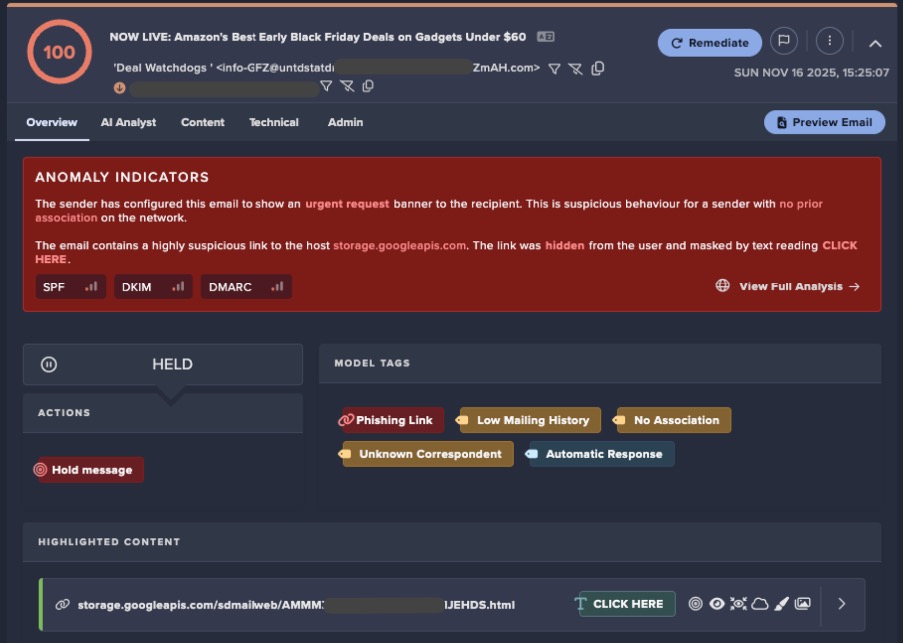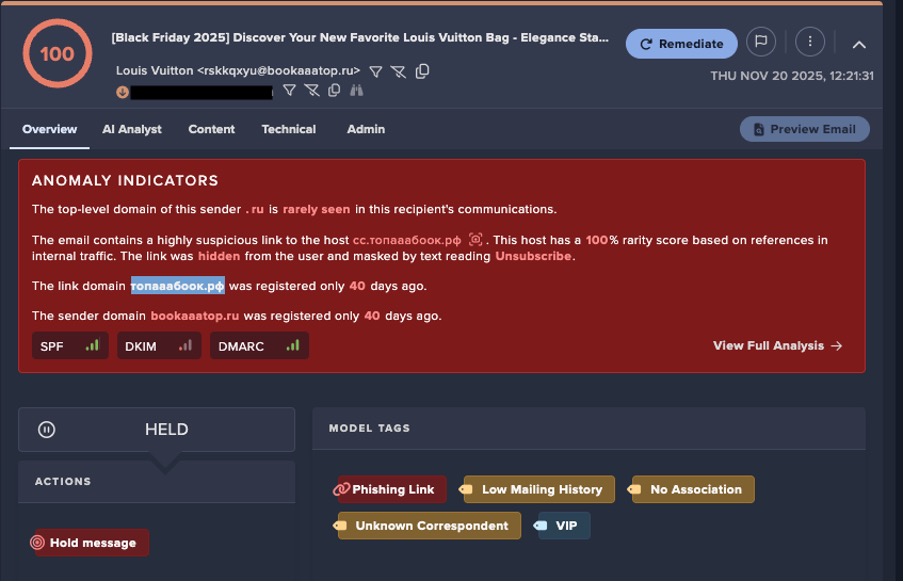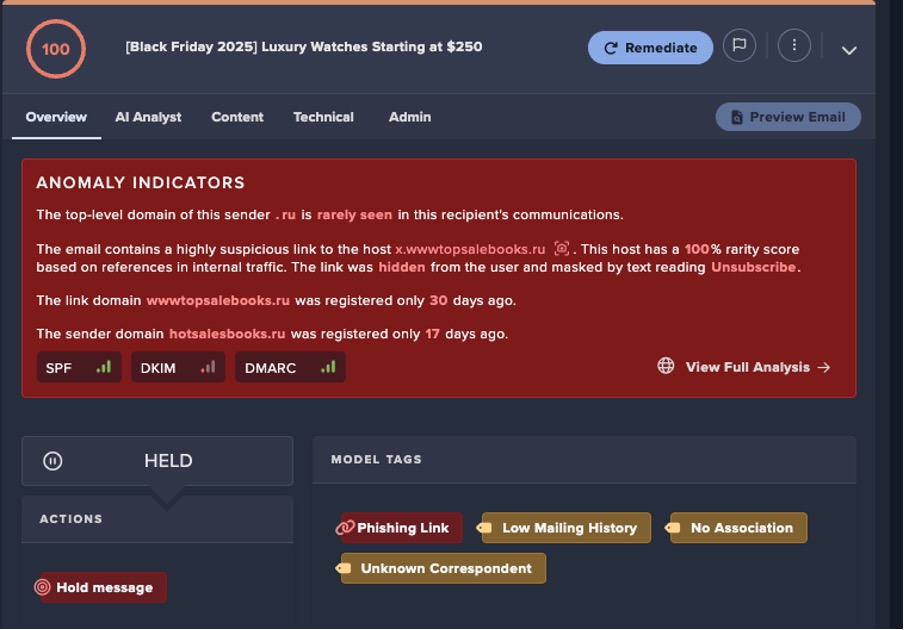The efficiency of a Security Operations Center (SOC) hinges on its ability to detect, analyze and respond to threats effectively. With advancements in AI and automation, key early SOC team metrics such as Mean Time to Detect (MTTD) have seen significant improvements:
- 96% of defenders believing AI-powered solutions significantly boost the speed and efficiency of prevention, detection, response, and recovery.
- Organizations leveraging AI and automation can shorten their breach lifecycle by an average of 108 days compared to those without these technologies.
While tool advances have improved performance and effectiveness in the detection phase, this has not been as beneficial to the next step of the process where initial alerts are investigated further to determine their relevance and how they relate to other activities. This is often measured with the metric Mean Time to Analysis (MTTA), although some SOC teams operate a two-level process with teams for initial triage to filter out more obviously uninteresting alerts and for more detailed analysis of the remainder. SOC teams continue to grapple with alert fatigue, overwhelmed analysts, and inefficient triage processes, preventing them from achieving the operational efficiency necessary for a high-performing SOC.
Addressing this core inefficiency requires extending AI's capabilities beyond detection to streamline and optimize the following investigative workflows that underpin effective analysis.
Challenges with SOC alert investigation
Detecting cyber threats is only the beginning of a much broader challenge of SOC efficiency. The real bottleneck often lies in the investigation process.
Detection tools and techniques have evolved significantly with the use of machine learning methods, improving early threat detection. However, after a detection pops up, human analysts still typically step in to evaluate the alert, gather context, and determine whether it’s a true threat or a false alarm and why. If it is a threat, further investigation must be performed to understand the full scope of what may be a much larger problem. This phase, measured by the mean time to analysis, is critical for swift incident response.
Challenges with manual alert investigation:
- Too many alerts
- Alerts lack context
- Cognitive load sits with analysts
- Insufficient talent in the industry
- Fierce competition for experienced analysts
For many organizations, investigation is where the struggle of efficiency intensifies. Analysts face overwhelming volumes of alerts, a lack of consolidated context, and the mental strain of juggling multiple systems. With a worldwide shortage of 4 million experienced level two and three SOC analysts, the cognitive burden placed on teams is immense, often leading to alert fatigue and missed threats.
Even with advanced systems in place not all potential detections are investigated. In many cases, only a quarter of initial alerts are triaged (or analyzed). However, the issue runs deeper. Triaging occurs after detection engineering and alert tuning, which often disable many alerts that could potentially reveal true threats but are not accurate enough to justify the time and effort of the security team. This means some potential threats slip through unnoticed.
Understanding alerts in the SOC: Stopping cyber incidents is hard
Let’s take a look at the cyber-attack lifecycle and the steps involved in detecting and stopping an attack:
First we need a trace of an attack…
The attack will produce some sort of digital trace. Novel attacks, insider threats, and attacker techniques such as living-off-the-land can make attacker activities extremely hard to distinguish.
A detection is created…
Then we have to detect the trace, for example some beaconing to a rare domain. Initial detection alerts being raised underpin the MTTD (mean time to detection). Reducing this initial unseen duration is where we have seen significant improvement with modern threat detection tools.
When it comes to threat detection, the possibilities are vast. Your initial lead could come from anything: an alert about unusual network activity, a potential known malware detection, or an odd email. Once that lead comes in, it’s up to your security team to investigate further and determine if this is this a legitimate threat or a false alarm and what the context is behind the alert.
Investigation begins…
It doesn’t just stop at a detection. Typically, humans also need to look at the alert, investigate, understand, analyze, and conclude whether this is a genuine threat that needs a response. We normally measure this as MTTA (mean time to analyze).
Conducting the investigation effectively requires a high degree of skill and efficiency, as every second counts in mitigating potential damage. Security teams must analyze the available data, correlate it across multiple sources, and piece together the timeline of events to understand the full scope of the incident. This process involves navigating through vast amounts of information, identifying patterns, and discerning relevant details. All while managing the pressure of minimizing downtime and preventing further escalation.
Containment begins…
Once we confirm something as a threat, and the human team determines a response is required and understand the scope, we need to contain the incident. That's normally the MTTC (mean time to containment) and can be further split into immediate and more permanent measures.
For more about how AI-led solutions can help in the containment stage read here: Autonomous Response: Streamlining Cybersecurity and Business Operations
The challenge is not only in 1) detecting threats quickly, but also 2) triaging and investigating them rapidly and with precision, and 3) prioritizing the most critical findings to avoid missed opportunities. Effective investigation demands a combination of advanced tools, robust workflows, and the expertise to interpret and act on the insights they generate. Without these, organizations risk delaying critical containment and response efforts, leaving them vulnerable to greater impacts.
While there are further steps (remediation, and of course complete recovery) here we will focus on investigation.
Developing an AI analyst: How Darktrace replicates human investigation
Darktrace has been working on understanding the investigative process of a skilled analyst since 2017. By conducting internal research between Darktrace expert SOC analysts and machine learning engineers, we developed a formalized understanding of investigative processes. This understanding formed the basis of a multi-layered AI system that systematically investigates data, taking advantage of the speed and breadth afforded by machine systems.
With this research we found that the investigative process often revolves around iterating three key steps: hypothesis creation, data collection, and results evaluation.
All these details are crucial for an analyst to determine the nature of a potential threat. Similarly, they are integral components of our Cyber AI Analyst which is an integral component across our product suite. In doing so, Darktrace has been able to replicate the human-driven approach to investigating alerts using machine learning speed and scale.
Here’s how it works:
- When an initial or third-party alert is triggered, the Cyber AI Analyst initiates a forensic investigation by building multiple hypotheses and gathering relevant data to confirm or refute the nature of suspicious activity, iterating as necessary, and continuously refining the original hypothesis as new data emerges throughout the investigation.
- Using a combination of machine learning including supervised and unsupervised methods, NLP and graph theory to assess activity, this investigation engine conducts a deep analysis with incidents raised to the human team only when the behavior is deemed sufficiently concerning.
- After classification, the incident information is organized and processed to generate the analysis summary, including the most important descriptive details, and priority classification, ensuring that critical alerts are prioritized for further action by the human-analyst team.
- If the alert is deemed unimportant, the complete analysis process is made available to the human team so that they can see what investigation was performed and why this conclusion was drawn.

To illustrate this via example, if a laptop is beaconing to a rare domain, the Cyber AI Analyst would create hypotheses including whether this could be command and control traffic, data exfiltration, or something else. The AI analyst then collects data, analyzes it, makes decisions, iterates, and ultimately raises a new high-level incident alert describing and detailing its findings for human analysts to review and follow up.

Learn more about Darktrace's Cyber AI Analyst
- Cost savings: Equivalent to adding up to 30 full-time Level 2 analysts without increasing headcount
- Minimize business risk: Takes on the busy work from human analysts and elevates a team’s overall decision making
- Improve security outcomes: Identifies subtle, sophisticated threats through holistic investigations
Unlocking an efficient SOC
To create a mature and proactive SOC, addressing the inefficiencies in the alert investigation process is essential. By extending AI's capabilities beyond detection, SOC teams can streamline and optimize investigative workflows, reducing alert fatigue and enhancing analyst efficiency.
This holistic approach not only improves Mean Time to Analysis (MTTA) but also ensures that SOCs are well-equipped to handle the evolving threat landscape. Embracing AI augmentation and automation in every phase of threat management will pave the way for a more resilient and proactive security posture, ultimately leading to a high-performing SOC that can effectively safeguard organizational assets.
Every relevant alert is investigated
The Cyber AI Analyst is not a generative AI system, or an XDR or SEIM aggregator that simply prompts you on what to do next. It uses a multi-layered combination of many different specialized AI methods to investigate every relevant alert from across your enterprise, native, 3rd party, and manual triggers, operating at machine speed and scale. This also positively affects detection engineering and alert tuning, because it does not suffer from fatigue when presented with low accuracy but potentially valuable alerts.
Retain and improve analyst skills
Transferring most analysis processes to AI systems can risk team skills if they don't maintain or build them and if the AI doesn't explain its process. This can reduce the ability to challenge or build on AI results and cause issues if the AI is unavailable. The Cyber AI Analyst, by revealing its investigation process, data gathering, and decisions, promotes and improves these skills. Its deep understanding of cyber incidents can be used for skill training and incident response practice by simulating incidents for security teams to handle.
Create time for cyber risk reduction
Human cybersecurity professionals excel in areas that require critical thinking, strategic planning, and nuanced decision-making. With alert fatigue minimized and investigations streamlined, your analysts can avoid the tedious data collection and analysis stages and instead focus on critical decision-making tasks such as implementing recovery actions and performing threat hunting.
Stay tuned for part 3/3
Part 3/3 in the Reimagine your SOC series explores the preventative security solutions market and effective risk management strategies.
Coming soon!































.jpg)



.avif)











%20(3).png)